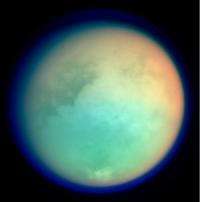Avoid swimming in interplanetary lakes: Research confirms oily 'water' on Saturn's moon

Titan, one of Saturn's moons, is the only moon in the solar system with an atmosphere -- ten times denser than the atmosphere of Earth. Five years ago, the Cassini-Huygens mission to Saturn, a collaboration between the European Space Agency and NASA, sent a probe through Titan's atmosphere, revealing that Titan is home to a landscape that includes hills, valleys and most notably lakes.
A researcher involved with the mission, Prof. Akiva Bar-Nun of Tel Aviv University's Department of Geophysics and Planetary Sciences, has now determined the composition of these lakes. Taking into account the chemical components of Titan's atmosphere, he has demonstrated that the lakes are not composed of water but contain liquid hydrocarbons like ethane and methane, which are also found in oil and gas wells on Earth.
His in-depth analysis of the chemical composition of Titan's atmosphere and lakes was recently published in the Journal of Geophysical Research - Planets.
Gases turned to rain
"Titan's unique atmosphere does not include nitrogen and oxygen like Earth's, but rather nitrogen and methane," Prof. Bar-Nun says. Solar irradiation of the methane in Titan's atmosphere produces a variety of hydrocarbon gases, which condense in the atmosphere and fall to the surface of Saturn's moon.
"Upon reaching the cold surface, they liquefy, raining down, flowing through the gullies and accumulating into lakes ― but you wouldn't want to jump into them on a summer holiday," he continues. Further solar irradiation of these hydrocarbons in the atmosphere also produces tiny globules of polymers, or aerosols, which give Titan its famed orange glow.
The chemical processes on Titan are different than those on Earth because there is no water vapor in Titan's air, leading to hydrocarbon-based lakes unlike those seen on our planet. Because of this, the frequent claims that Titan could be a laboratory for the investigation of life's emergence on Earth are unfounded, he says.
From Titan to Siberia?
Prof. Bar-Nun says that these recent findings confirm predictions that he made in 1979, when he first developed the theory that there were lakes on Titan. Upon falling to the moon's surface, he theorized, the hydrocarbons in the atmosphere would form lakes with a depth of approximately 43 meters had they been covering the entire surface of Titan. In addition, he hypothesized that the same elements would form aerosols in the atmosphere.
The Cassini-Huygens mission also confirmed a prediction that Prof. Bar-Nun and his fellow researchers made in 1999 regarding the height of mountains on Titan. Titan's water-ice crust, he explains, has similar properties to the permafrost found in Siberia. Being partly fluid, permafrost permits hills and mountains to rise no higher than 1,900 meters, or approximately 6,200 feet. And indeed, no hill or mountain on Titan's surface exceeds that height, the researchers found.
Provided by Tel Aviv University

















